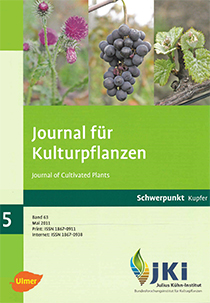Bioavailable copper and other heavy metal contents in organically and conventionally managed German vineyard and hop soils.
Part 3: Determination of plant available contents of copper and other heavy metals by NH<sub>4</sub>NO<sub>3</sub>-extraction
DOI:
https://doi.org/10.5073/JfK.2011.05.03Keywords:
Copper, bioavailability, vine, hop, Plasmopara viticola, Pseudoperonospora humuli, load distribution, risk assessment, selection of monitoring areasAbstract
Objective of the examinations is to indentify relations between plant available copper contents in vineyard and hop soils and management or natural factors.
2522 single soil samples were collected on 85 vineyard and 13 hop areas. Samples were taken on cultivated, fallow and uncultivated soils and plant-available copper contents were analyzed in NH4NO3 extract (DIN, 1997). Additionally soil parameters as pH-value, C/N ratio, soil type etc. were analyzed (VDLUFA, 1991).
A strict relation between plant-available and total copper contents could not be verified. It is considered that the availability of copper being related to a specific goal of protection may depend on a variety of pedological, ecological and cultivation related influences not allowing an exposure assessment for groups of soil organisms relevant for a sustainable culture by using a specific extraction method like e.g. ammonium nitrate. It will be up to additional specific investigations to identify the main factors (e.g. soil management or culturing techniques) responsible for the extent of bioavailability, and to quantify their impact.
Downloads
Published
Issue
Section
License
The content of the journal is licensed under the Creative Commons Attribution 4.0 License. Any user is free to share and adapt (remix, transform, build upon) the content as long as the original publication is attributed (authors, title, year, journal, issue, pages).
The copyright of the published work remains with the authors. The authors grant the Journal of Cultivated Plants, the Julius Kühn-Institut and the OpenAgrar repository the non-exclusive right to distribute and exploit the work.







